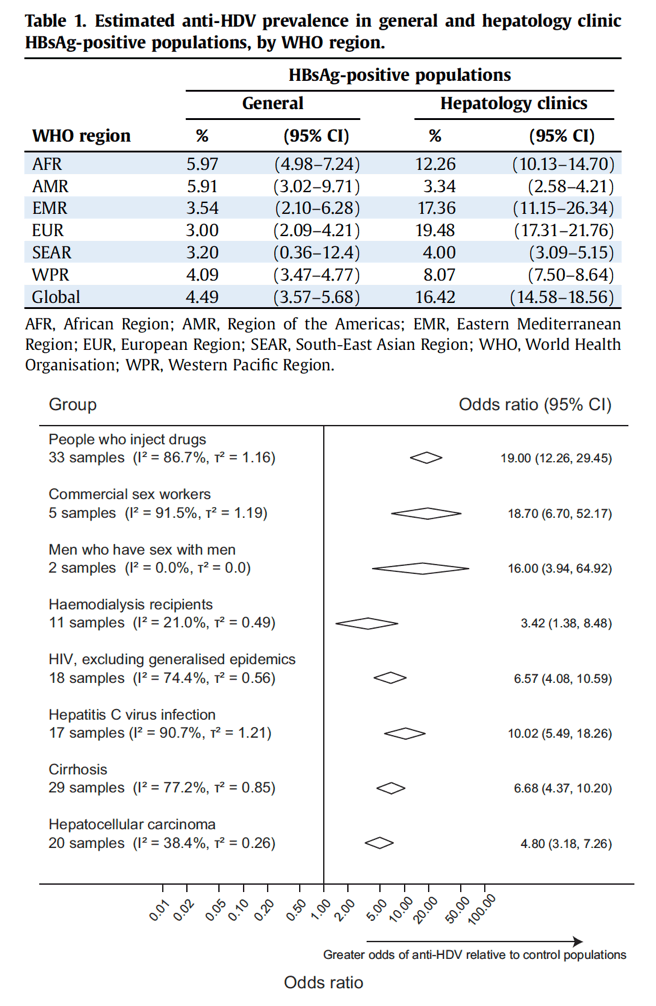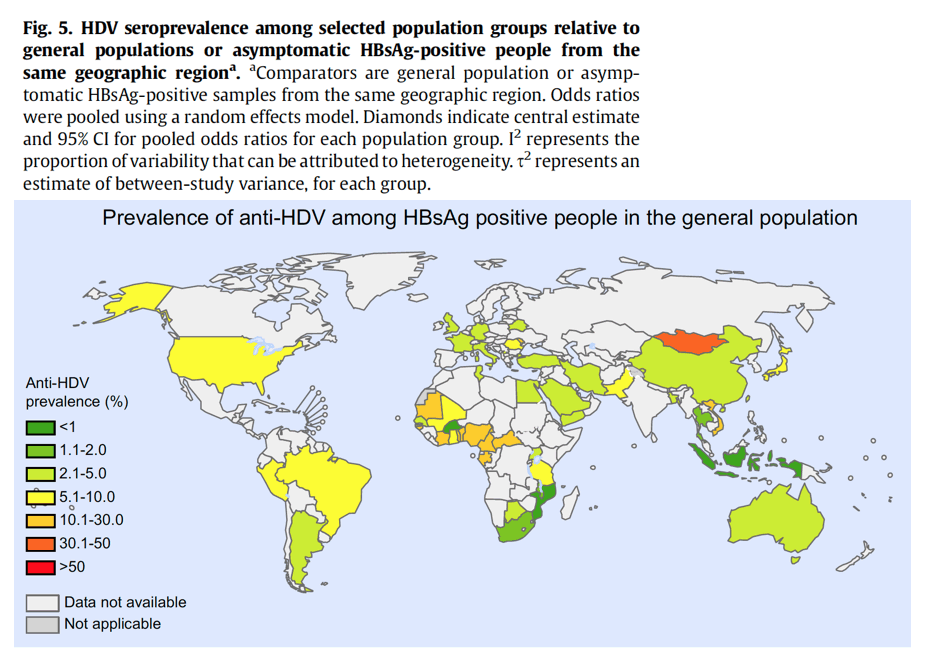| |
Hepatitis D Changing Context Global Prevalence
|
| |
| |
The global prevalence of hepatitis D virus infection:
Systematic review and meta-analysis
The Changing Context of Hepatitis D
Delta hepatitis within the Veterans Affairs medical system in
the United States: Prevalence, risk factors, and outcomes
AASLD: Hepatitis D Delta Overview; New AASLD 2021 Treatment Studies (12/06/21)
AASLD: Hepatitis D (Delta) at AASLD 2021 (12/06/21)
3 articles on Hepatitis D

January 20, 2021
In Europe, the clinical features of current CHDs are different in the domestic ageing survivors of infection acquired decades ago and in the younger immigrants importing new disease.
The mean age of native Italians with CHD identified between 2010 and 2019 was 58 years and all had extensive liver fibrosis or overt cirrhosis, demonstrated by a median liver stiffness of 12 kPa on Fibroscan®.This cohort still has an impact on liver transplantation programmes. Despite the much lower epidemiologic burden of HDV compared to HBV, the proportion of liver transplants in HDV-infected vs. total HBsAg-positive transplants has remained stable in the last 20 years in Italy (∼45%) as well as in the European Liver Transplant Registry (~25%).This can be explained by the effective control of hepatitis B afforded by antivirals in contrast with the poor efficacy of therapeutic options available for HDV, which cannot prevent progression to end-stage cirrhosis in most cases.
Summary
The global epidemiology of hepatitis D is changing with the widespread implementation of vaccination against hepatitis B. In high-income countries that achieved optimal control of HBV, the epidemiology of hepatitis D is dual, consisting of an ageing cohort of domestic patients with advanced liver fibrosis who represent the end stage of the natural history of HDV, and of a younger generation of immigrants from endemic countries who account for the majority of new infections. As observed in Europe in the 1980s, the distinctive clinical characteristic of chronic hepatitis D in endemic countries is the accelerated progression to cirrhosis and hepatocellular carcinoma. Despite some recent progress, the therapeutic management of HDV remains unsatisfactory, as most patients are not cured of HDV with currently available medicines. This review article describes the current epidemiology and clinical features of chronic hepatitis D, based on the literature published in the last 10 years.
In high income countries, vaccination programmes against HBV started in the 1990s. At present, the younger generations are protected from HBV and by default from HDV.[14],[15]
The decline in infection has been age-dependent and most marked in the youngest cohorts. As an example, of 513 Italian HBsAg carriers identified in 2014, 61 were positive for anti-HD but only 3% were younger than 30, while 80% were 50 years or older.[16]
In Europe, HDV remains endemic in Romania[17] and Moldova.[18] Hot spots sustained by immigrants and intravenous drug users (IVDUs) have been reported in Russia.[19],[20]
IVDUs are the group at highest risk of hepatitis D.[21] However, the HDV scenario is also changing in IVDUs in Europe, reflecting the impact of HBV vaccination and the success of harm reduction programmes. In Spain, the prevalence of anti-HD among active HBsAg-positive IVDUs declined from 30% in the 1990s to 4.2% in 2018.[22] In a nationwide study from Italy in 2012, only 2.8% of 543 IVDUs with HCV infection were also HBsAg carriers susceptible to HDV infection.[23] Surprisingly, despite a successful HBV vaccination programme in Taiwan, as many as 43.9% of 164 HBsAg-positive IVDUs enrolled from 2001 to 2012 had anti-HD.[24] However, over half of them were over 40 years and presumably had been infected decades before. Nevertheless, the rate of HDV has remained consistent in HBsAg-positive IVDUs infected with HIV.[12], [25],[26] On the other hand, although mercenary sex was considered an important risk factor for HDV transmission in the 1990s,[27] it has not been reported in the literature of the last decade, except in a recent study from Thailand that found no HDV marker in HBsAg-positive migrant sex workers. [28]
In Europe, the demise of HDV in domestic populations has been offset by new infections introduced by immigrants from areas where HDV remains endemic.[29] The relative proportion of HDV-infected migrants is increasing compared to HDV-infected native populations[30]; migratory flows have interrupted the decline in infections, whose prevalence in HBsAg carriers stabilised in the last decade at 8-10% i n Germany, Italy, Spain and France.[31] The pattern of decreasing domestic and increasing migrant HDV infections is being observed in all high-income countries.32, 33, 34
-----------------------------

Tatyana Kushner - May 08, 2015
Background & Aims
Low hepatitis delta prevalence estimates in the United States are likely biased due to low testing rates. The objectives of this study were to quantify the prevalence of testing and identify factors associated with hepatitis D positive status among chronic hepatitis B patients in the Veterans Health Administration.
Methods
We performed a nationwide retrospective study of all veterans who tested positive for HBsAg from October 1999 to December 2013. Hepatitis D antibody testing results were used to stratify patients into three groups: HDV-positive, HDV-negative, and HDV-not tested. Demographics, comorbidities, additional laboratory data and clinical outcomes were compared across these groups of patients using standard statistical approaches.
Results
Among 25,603 patients with a positive hepatitis B surface antigen, 2175 (8.5%) were tested for HDV; 73 (3.4%) patients tested positive. Receiving HDV testing was associated with receipt of testing for HBV, HIV, and HCV. Predictors of positive HDV results included substance abuse and cirrhosis. Fitting a predefined high-risk profile (abnormal ALT with suppressed HBV DNA titers) was strongly associated with testing positive for HDV (OR 3.2, 95%CI 1.4-7.5). Most (59%) of HDV-positive patients were HCV co-infected. HDV-positive subjects had higher risks of all-cause mortality. Incidence rates of HCC were 2.9 fold higher in HDV-positive relative to HDV-negative individuals (p = 0.002). In adjusted analyses, HDV was independently associated with HCC (OR 2.1, 95%CI 1.1-3.9).
Conclusions
Testing rates for hepatitis delta in chronic hepatitis B patients in the United States are inappropriately low. Approaches to increase testing for HDV particularly in high-risk subsets should be explored.
--------------------------

April 23, 2020
Hepatitis D is widely distributed but neglected disease. . The data also indicate that PWID, haemodialysis recipients, CSWs and MSM, as well as people with HIV and HCV, are at increased odds of HDV seropositivity, and that HDV is responsible for a substantial proportion of cirrhosis and HCC among HBsAg-positive people. HDV infection should be considered in all patients with chronic HBV infection. Routine HDV ascertainment in clinical settings is of particular importance in view of the suppressive effect of HDV co-infection on HBV DNA levels,
[28] which may lead to misclassification of HBV status.
Globally, we estimate an anti-HDV prevalence of 4.5% among HBsAg-positive people, which translates into an estimated prevalence of 0.16% in the total population. This represents an estimated 12 million people with serological evidence of HDV infection globally. The geographic distribution of HDV infection is heterogeneous, with particularly high prevalence reported in Mongolia, the Republic of Moldova, and countries in Western and Middle Africa. We also identified an epidemiological association between anti-HDV prevalence and several population groups including PWID, recipients of haemodialysis, CSWs and MSM, and between anti-HDV prevalence and HCV or HIV infection, which may be secondary to shared transmission routes. These data are useful to set priorities about HDV testing. Interventions that prevent HBV and HCV infection should also be effective in preventing HDV, including immunization against hepatitis B and harm reduction strategies in PWID.
There remain limitations to the epidemiological data available to inform this analysis. There are significant data gaps, most strikingly in North America and Latin America, Southern Africa and most of Asia, where more data are required to obtain accurate estimates of anti-HDV prevalence.
Unbiased ascertainment of anti-HDV prevalence requires large sample sizes to identify the subset with HBV, which poses a particular problem in regions with low HBV prevalence. In these regions, samples derived from settings that are enriched with HBsAg-positive people are often used to study anti-HDV prevalence, such as patients sampled within hepatology clinics. Current guidelines recommend HDV testing in selected patients with specific risk factors or do not explicitly recommend universal testing.
As a result, in many centres, newly diagnosed HBsAg-positive individuals are not tested for anti-HDV as part of routine practice. Clinician-driven testing carries a risk of introducing an ascertainment bias.
Anti-HDV prevalence in selected population groups
The odds of anti-HDV detection were analysed in 6 selected populations relative to general populations or asymptomatic HBsAg-positive people from the same geographic region (Fig. 6 and supplementary appendices 14-20). Anti-HDV prevalence was higher in PWID (pooled OR 19.0) and in haemodialysis recipients (pooled OR 3.4). Five studies from China and Vietnam indicated that CSWs also had higher prevalence (pooled OR 18.7). Three studies from Italy, Burkina Faso and Indonesia investigated anti-HDV prevalence among MSM. No cases were reported in the Burkina Faso study, whereas data from the other 2 studies indicated that anti-HDV prevalence was higher among MSM (pooled OR 16.0). The odds of anti-HDV detection were also higher among anti-HCV positive people (pooled OR 10.0) and among HIV-positive people in countries without generalised HIV epidemics (pooled OR 6.6). In countries with generalised HIV epidemics, the odds of anti-HDV detection were similar in HIV-positive and HIV-negative people (pooled OR 0.8).
Population attributable fraction for cirrhosis and HCC among HBsAg-positive people
Patients with cirrhosis or HCC had higher anti-HDV prevalence relative to comparator populations from the same geographic region, with pooled ORs of 6.7 and 4.8, respectively (Fig. 5 and supplementary appendices 24 and 25). Among HBsAg-positive people with sequelae of infection, our PAF calculation suggested that HDV accounted for 18% of cirrhosis (95% CI 10-26) and 20% of HCC (95% CI 8-33) (supplementary appendices 26 and 27).


|
|
| |
| |
|
|
|